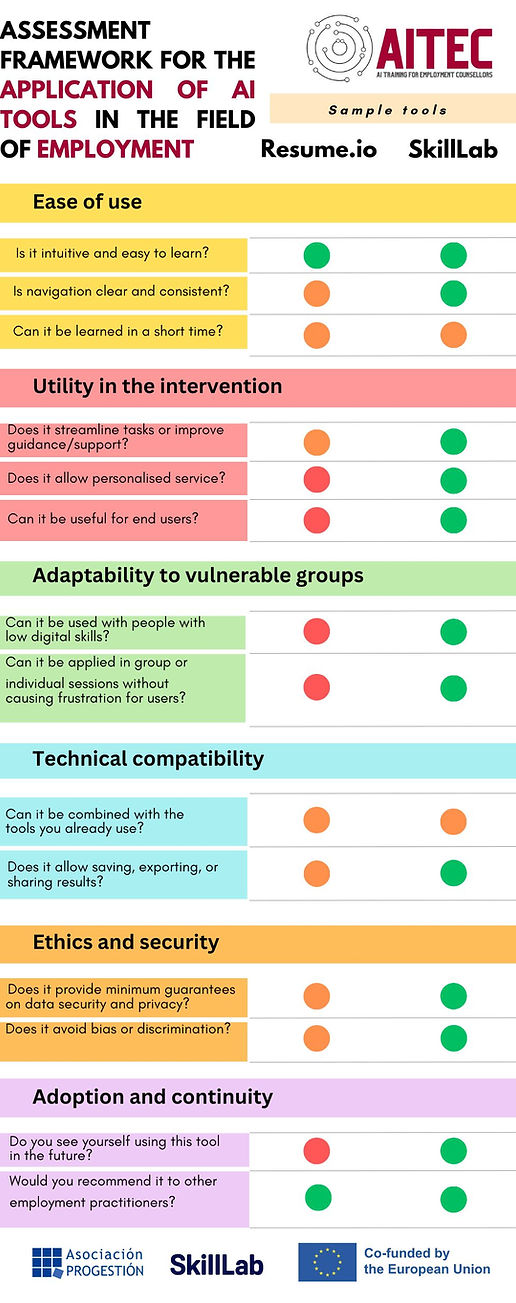Assessment Framework
Choosing the Right AI Tools for Your Work
With so many options of new AI tools, how can you determine which ones are a good fit for you, your organization, and the beneficiaries you support?
The Assessment Framework helps you answer that question. It provides a structured guide with key questions to help you evaluate the suitability, utility, and safety of AI-based tools for your daily work. By using this framework, you can make informed decisions, ensuring that any new technology you adopt is effective, secure, and genuinely beneficial for your beneficiaries.
How to Use the Framework
Think of this framework as a checklist. Before committing to a new tool, walk through the categories and questions below. Discuss them with your team and consider running a small pilot test with a few colleagues or beneficiaries. Your answers will help you build a clear picture of whether a tool is worth your time and resources.
For a quick assessment, try to rate each category below for a tool you're currently trying and click on the "Assessment" button to see if it's is a fit for you!
Is it intuitive and easy to learn?
Is navigation clear and consistent?
Can it be learned in a short time?
Does it streamline tasks to improve guidance / support?
Does it allow personalised service?
Is it useful for end users?
Can it be used with people with low digital skills?
Can it be applied in group or individual sessions without causing frustration for users?
Can it be combined with the tools you already use?
Does it allow saving, exporting, or sharing results?
Does it provide minimum guarantees on data security and privacy?
Does it avoid bias or discrimination?
Do you see yourself using this tool in the future?
Would you recommend it to other employment practitioners?
Click the "Assessment" button to display your result.
The Assessment Categories
The framework is divided into six key categories. Here is a brief explanation of why each is relevant for employment counsellors:
1. Ease of Use
A tool is only effective if you and your beneficiaries can use it without frustration. Complex tools can create new barriers rather than remove them, particularly when working with individuals who have low digital skills.
-
Is the tool intuitive and easy to learn?
-
Is its navigation clear and consistent?
-
Can it be learned in a short amount of time?
2. Utility in the Intervention
The primary goal of any tool should be to enhance your intervention process. It should add clear value to your core tasks, whether by saving time on administrative work or by improving the quality of guidance you provide to beneficiaries.
-
Does it streamline tasks or improve guidance and support?
-
Does it allow for personalized assistance or service?
-
Is it useful for the end-users (the job seekers)?
3. Adaptability to Vulnerable Groups
Counsellors in non-profit organizations often support individuals facing multiple barriers, including limited access to technology and low digital literacy. It is crucial that any new tool is inclusive and accessible, empowering all users instead of creating additional hurdles.
-
Can it be used by people with low digital skills?
-
Can it be applied in group or individual sessions without causing frustration for users?
4. Technical Compatibility
To ensure an efficient workflow, a new tool needs to integrate smoothly with the systems and software you already use daily, allowing for easy management and sharing of information.
-
Can it be combined with the tools you already have?
-
Does it allow you to save, export, or share results?
5. Ethics and Security
Handling personal data is a core responsibility in employment counseling. Any AI tool you use must comply with data protection regulations like GDPR and be designed to prevent algorithmic bias that could lead to unfair or discriminatory outcomes.
-
Does it provide minimum guarantees on data security and privacy?
-
Does it avoid bias or discrimination?
Assessment: Example

6. Adoption and Continuity
Choosing a tool is a commitment. Before fully adopting it, consider its long-term viability for your organization. A tool that is quickly abandoned can be a waste of valuable time and resources.
-
Do you see yourself using this tool in the future?
-
Would you recommend it to other employment practitioners?
You can download the Assessment Framework example as a pdf document here: Assessment Example (English, 358KB).